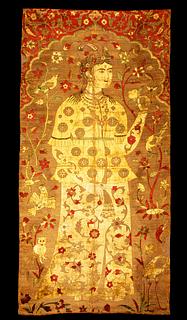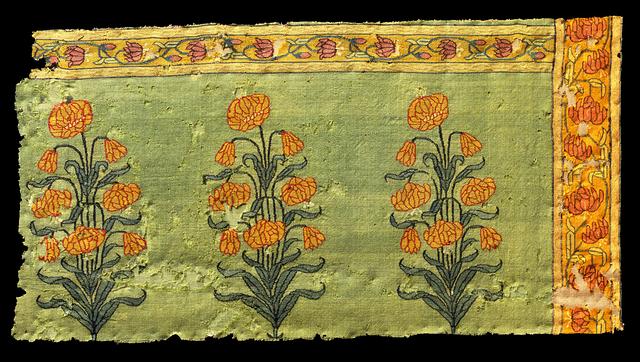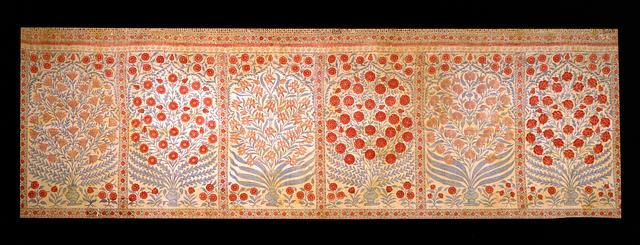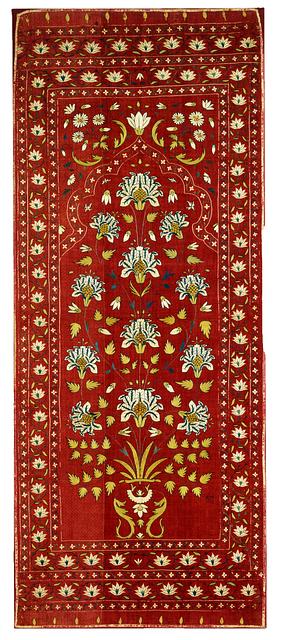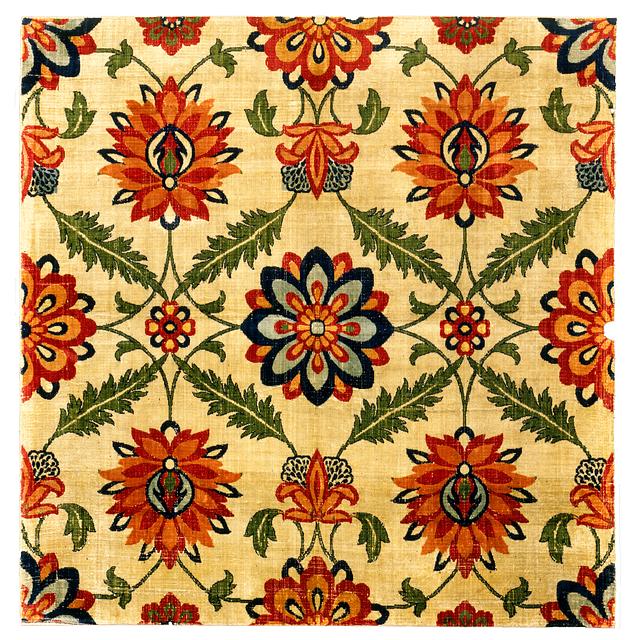Fløjlsbane af silke og silke omvundet med sølvlamel
Indien eller Iran; omkring 1600
H: 143; B: 69 cm
Inventarnummer 37/1995
I sin størrelse og i sit ikke-gentagne mønster er denne monumentale skildring af en stående kvinde i en svejfet bue helt unik. Det var først og fremmest væverne fra det safavidiske Iran, der var kendte for at udføre disse teknisk set helt uovertrufne tekstiler, men i stormogulen Akbars biografi hævdes det, at inderne omkring 1600 var nået lige så langt i teknisk kunnen.
Farverne, buen, dragten, hårsmykket, ”kastemærket” og den relativt naturalistiske gengivelse af planter peger alle i retning af Indien som fremstillingssted.
Man må forestille sig, at dette tekstil sammen med andre beslægtede har prydet et fyrsteligt pragttelt.
Farverne, buen, dragten, hårsmykket, ”kastemærket” og den relativt naturalistiske gengivelse af planter peger alle i retning af Indien som fremstillingssted.
Man må forestille sig, at dette tekstil sammen med andre beslægtede har prydet et fyrsteligt pragttelt.
Publiceret i
Publiceret i
Phillips, London, 19/5-1995, lot 29;
Kjeld von Folsach: Kunst fra islams verden i Davids Samling, København 2001, kat.nr. 663;
Sheila S. Blair og Jonathan M. Bloom (red.): Cosmophilia. Islamic Art from the David Collection, Copenhagen, McMullen Museum of Art, Boston College, Boston 2006, kat.nr. 1;
Steven Cohen: “The use of fine goat hair for the production of luxury textiles: its origins and the similarities and differences of its use in Iran and India during the reigns of the Safavid and Mughal shahs” i Jon Thompson, Daniel Shaffer og Pirjetta Mildh (red.): Carpets and textiles in the Iranian world 1400-1700 : proceedings of the conference held at the Ashmolean Museum on 30-31 August 2003, Oxford 2010, s. 126, fig. 3;
Rahul Jain: Rapture: the art of Indian textiles, New Delhi 2011, kat.nr. 20, s. 68-69;
Steven Cohen: “Two outstanding Mughal qanat panels in the David Collection, with technical analyses and drawings of weaving structures by Anne-Marie Keblow Bernsted” i Journal of the David Collection, 4, 2014, s. 172, fig. 2 og s. 200-201, fig. 14;
Daniel C. Waugh: "The David Collection: Journal of the David Collection. 4," i The Silk road, 2014, 12, Featured museum, I: s. 132-136, fig. 5;
Louise W. Mackie: Symbols of power: luxury textiles from Islamic lands, 7th–21st century, Cleveland 2015, fig. 10.8, s. 416-417;
Sylvia Houghteling: The art of cloth in Mughal India, Princeton 2022, s. 181, fig. 4.23;
Kjeld von Folsach: Kunst fra islams verden i Davids Samling, København 2001, kat.nr. 663;
Sheila S. Blair og Jonathan M. Bloom (red.): Cosmophilia. Islamic Art from the David Collection, Copenhagen, McMullen Museum of Art, Boston College, Boston 2006, kat.nr. 1;
Steven Cohen: “The use of fine goat hair for the production of luxury textiles: its origins and the similarities and differences of its use in Iran and India during the reigns of the Safavid and Mughal shahs” i Jon Thompson, Daniel Shaffer og Pirjetta Mildh (red.): Carpets and textiles in the Iranian world 1400-1700 : proceedings of the conference held at the Ashmolean Museum on 30-31 August 2003, Oxford 2010, s. 126, fig. 3;
Rahul Jain: Rapture: the art of Indian textiles, New Delhi 2011, kat.nr. 20, s. 68-69;
Steven Cohen: “Two outstanding Mughal qanat panels in the David Collection, with technical analyses and drawings of weaving structures by Anne-Marie Keblow Bernsted” i Journal of the David Collection, 4, 2014, s. 172, fig. 2 og s. 200-201, fig. 14;
Daniel C. Waugh: "The David Collection: Journal of the David Collection. 4," i The Silk road, 2014, 12, Featured museum, I: s. 132-136, fig. 5;
Louise W. Mackie: Symbols of power: luxury textiles from Islamic lands, 7th–21st century, Cleveland 2015, fig. 10.8, s. 416-417;
Sylvia Houghteling: The art of cloth in Mughal India, Princeton 2022, s. 181, fig. 4.23;
